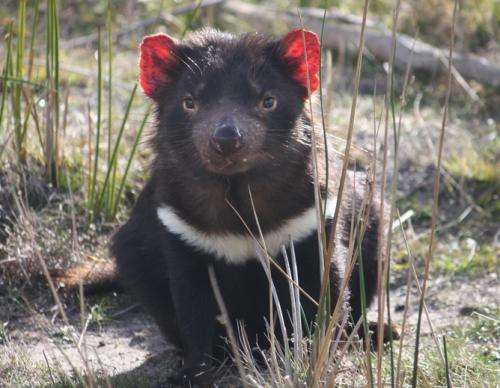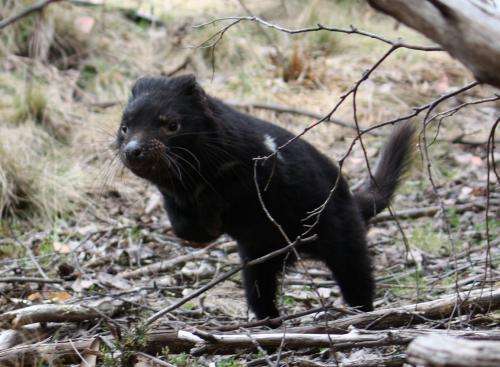Tasmanian devils survived two big falls in numbers but now need help

Most people probably know the Tasmanian devil as the iconic animal from Australia's island state of Tasmania. Fewer know that, up until a few thousand years ago, devils were widespread across mainland Australia.
But something happened during the past 10,000 years and devils disappeared from the mainland, leaving behind only bones in caves from the south-west of Western Australia, across the Nullarbor, to Victoria and New South Wales. It is unclear exactly when or why they disappeared. Changes in climate, hunting by humans or the introduction of the dingo have all been proposed as likely candidates.
In contrast, devils survived in Tasmania, apparently in healthy numbers at the time of European arrival.
Like many island species, devils appear to have been saved from total extinction by being marooned on the island of Tasmania. There, they were cut off from any influence by dingos and possibly buffered against the effects of climate change.
The deadly facial cancer
The Tasmanian devil made headlines in 1996 when animals with large facial tumours were found at Mt William in the north-east corner of the island state. The disease, aptly named Devil Facial Tumour Disease (DFTD), is unique in that it is transferred as live tumour cells between individuals and is consistently fatal.
In less than two decades DFTD has spread to the majority of the devils' geographic range, causing more than 80% population declines. Today, devils are once again threatened with total extinction.
Large-scale efforts are underway to protect devil populations in the wild and to establish insurance populations in zoos and on offshore islands, free of the disease.
In the past ten years Tasmanian devil research has rightly focused on the origin, spread and impacts of DFTD on devil populations.

A major outcome of this research has highlighted the unusually low genetic diversity in Tasmanian devil populations – a feature at odds with their large pre-DFTD population size.
This low diversity is a major extinction risk factor in itself but may also have contributed to the rapid spread of DFTD from its origin at Mt William. Climatic or environmental effects may have caused low genetic diversity long before Europeans arrived in Tasmania.
Alternatively, genetic declines may have occurred rapidly in the past 200 years as a result of land clearing, introduced disease or hunting.
Why the low diversity?
In a paper published today in the journal Biology Letters, we used a large genetic data-set from more than 300 modern and historical devils to reconstruct changes in past population size. The aim was to understand what may have caused population declines and loss of genetic diversity.
Using DNA from Tasmanian devils sampled in 2004–2005 from nine sites across the island, and samples from 1964 from Mt William, we used new statistical methods to estimate past and current population sizes and piece together the history of devils in Tasmania.
Our results show that Tasmanian devils have suffered (but survived) two major population declines and have had a low genetic diversity for thousands of years.
These declines occurred before 20,000 years ago, corresponding to the last glacial maximum, and around 2,000 to 4,000 years ago, about the time of an increase in El Niño–Southern Oscillation activity.
Limited prey
Both climatic events resulted in a much drier climate. These more arid conditions may have resulted in changes in vegetation, influenced prey abundance and altered den site availability – with negative impacts on devil population size.
As a top predator, devil population density is known to be largely driven by prey abundance, so a decline in wallaby and small mammal numbers would have had a dramatic effect on devil population size.
Our research shows that devils did not lose genetic diversity rapidly in the past 200 years as a result of human activities or as the result of DFTD. Rather they have survived for thousands of years with low genetic diversity as the result of environmental change.
The low genetic diversity is a major extinction threat to the species. Devils highlight the precarious state of many species whose numbers appear to be secure.
The arrival of any new disease or rapid changes in the environment can have dramatic and disastrous effects. The combined effects of DFTD and predicted climate changes make it imperative that conservation measures are taken to assure the survival of the Tasmanian devil in the wild.
Trapped on the island of Tasmania, devils have survived two major population declines in the past, but will they endure these current threats?
More information: Anna Brüniche-Olsen, Menna E. Jones, Jeremy J. Austin, Christopher P. Burridge, and Barbara R. Holland. "Extensive population decline in the Tasmanian devil predates European settlement and devil facial tumour disease." Biol. Lett.. 2014 10 11 20140619; DOI: 10.1098/rsbl.2014.0619 (published 5 November 2014) 1744-957X
Journal information: Biology Letters
Provided by The Conversation




















